It sure doesn’t feel like September yet, does it?! The kids are back in school, the bucks have once again grown their antlers, the days are getting shorter, and some of the songbirds have already headed south for the winter, but it’s still in the 90s. I’m actually giving you winter squash this week which feels absolutely nuts to me given the weather, but they ripened up a little earlier this year (due to said weather) and it IS technically meteorologic fall when it’s normally a good time to start giving you these kinds of veggies. The good thing about winter squash is that you can just stick it in a cool, dark place for several months if you’re not quite ready for it yet. Hopefully you won’t have to wait that long to enjoy it and it will be fall (for real!) soon!
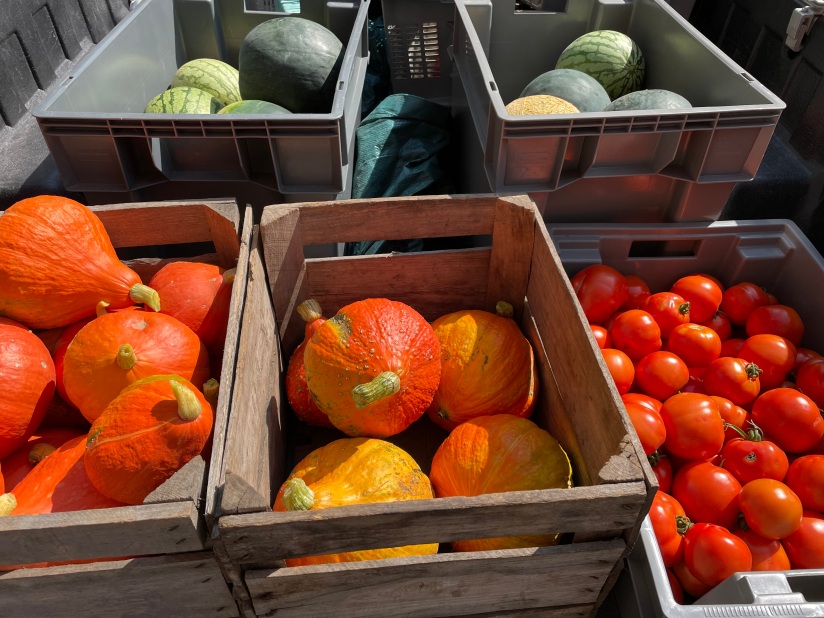
What’s in My Box this Week?

Brussels Sprouts – Store in a bowl or open container in the fridge. Do not trim or discard outer leaves before storage. Brussels sprouts should last up to a month this way. The outer leaves might get a little shriveled, but you typically remove them anyway.
Cherry or Saladette Tomatoes – Cherry tomatoes can over-ripen quickly, so it can be a good idea to store them in the fridge if you’re not going to eat them right away.
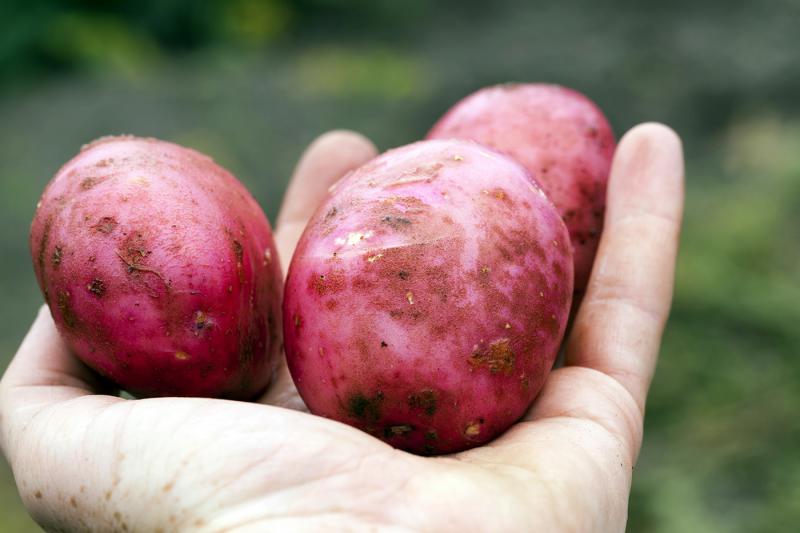
Dark Red Norland Potatoes – Dark Reds are great steamed or boiled right out of the garden with some butter and herbs. Keep unwashed potatoes in a cool, dark, dry place, such as a loosely closed paper bag in a cupboard. They will keep for two weeks at room temperature.
Garlic – Keep in a dark, dry, well-ventilated place at a cool room temperature. It can keep for several months if stored appropriately. Warm temperatures will encourage the cured garlic to sprout which will reduce the quality of it.
Italian Frying Peppers or Sweet Bell Peppers – Some of the peppers you’ll be getting this week won’t have completely turned color yet. I am finding that if I leave them on the plant until they are fully ripened, then some insect or other comes along and starts chomping them and then I can’t give them to you. To finish ripening them up, simply put them on a sunny counter for a few days until they finish turning color. Once that happens, refrigerate them unwashed in a sealed plastic bag in the crisper drawer for one to two weeks.

Lettuce – Store loosely in a plastic bag in the crisper drawer of your fridge. Keep unused leaves on the head. Ideally use within a week, but it will probably store for up to two weeks if needed. (Photo: Johnny’s Seeds)
Parsley – Store in the fridge in a small glass with about an inch of water, stem side down (like flowers in a vase) for best storage.
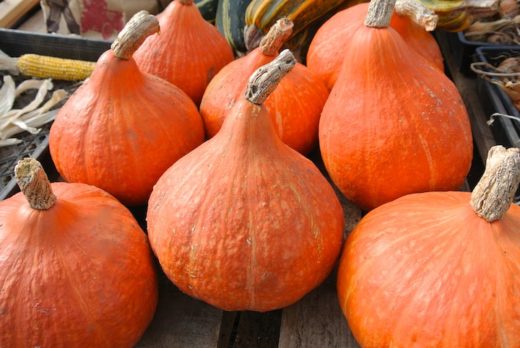
Potimarron Squash – This is a beautiful small, reddish-orange winter squash that originated in France. Its name derives from the French for pumpkin (potiron) and chestnut (marron) because it has a chestnut-like flavor.
Store winter squash in a cool, dry place and try to use within a week or two, although potimarrons will keep for several months if stored properly. Do not store in the fridge. This will cause it to spoil much more quickly.
Pickling Cucumbers (Large Share and Some Standard Shares) – I would have had enough for everyone, but the high temperatures caused a lot of flowers to abort and the pollinators just stay home when it’s too hot, so fewer fruits were set this past week.

These cukes are much shorter and plumper than English cucumbers. While you don’t have to use them for pickles (you can just eat them as you would any other cucumber), they make great homemade pickles that will keep in your fridge for months, no canning involved.
The Recipes Archives has some quick and easy recipes for doing this (look under “Cucumbers” and there are a couple recipes below, too. One pound of pickling cucumbers makes about a quart of pickles. To store, place them in a sealed plastic bag in the crisper drawer of the refrigerator for up to a week.
Slicer Tomatoes –Store at room temperature for up to a week. Do not refrigerate.
Watermelon – To store, refrigerate right away as watermelons don’t continue to ripen once picked. Cut melon should be covered in plastic wrap, and chunks or slices should be kept in an airtight container. Eat melons within a week.
Featured Veggie: Italian Frying Peppers
I decided add Italian Frying Peppers to the typical mix of sweet peppers this year because I read the words “growing your own Italian frying peppers is probably the only way many of us will ever replicate this Italian delicacy” in one description of them. Since I love Italian food – Erik and I can still remember every meal we ate when we traveled around Italy shortly after we were married – I couldn’t resist trying to grow them.
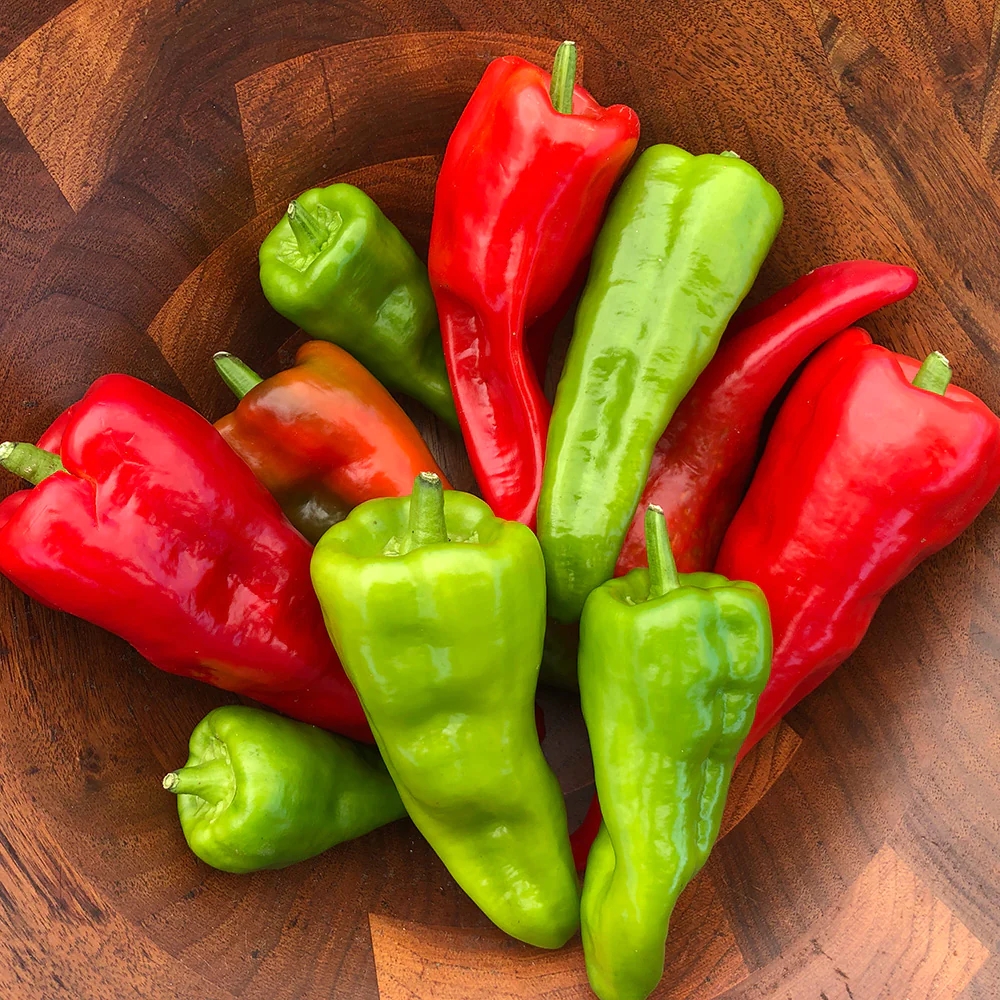
Italian frying peppers are smaller than bell peppers, coming in at around 6” long and tapering from the stem to the tip. Their flesh is thinner and with fewer seeds, tasting both sweet and just a tiny bit spicy. Unlike other peppers, they are sweet when both unripe (green) and ripe (yellow, orange, or red), and frying them – as their name implies you ought to do – lends them a subtle smoky flavor. (Photo: True Love Seeds)
We are growing two varieties this year: Carmen F1 and Escamillo F1, both of which are hybrids of the Corno di Toro (or Bull’s Horn) type that’s supposed to be vigorous, easy to grow, and delicious. Carmen F1 is a bright red pepper when ripe and was a 2006 All-America Selection winner and Escamillo F1, which is golden-colored, was selected in 2016. These two varieties draw their name from the French opera in which the gypsy Carmen falls in love with the bull fighter Escamillo.
Besides frying them, they can be enjoyed fresh, grilled, or in just about any Italian dish that calls for peppers.
Notes from the Field (and the Kitchen)
We are so over the heat! This past weekend, out of protest of the weather, I decided to do the absolute bare minimum in the field (i.e., watering!) and move operations inside where it was cooler. Thus, we Saturday making salsa. Luka and I harvested the poblanos and tomatoes. Simon and his buddy, Jace, gathered all the cilantro in the field, and we all acted as Erik’s sous chefs, prepping ingredients, while Erik did the brunt of the work.


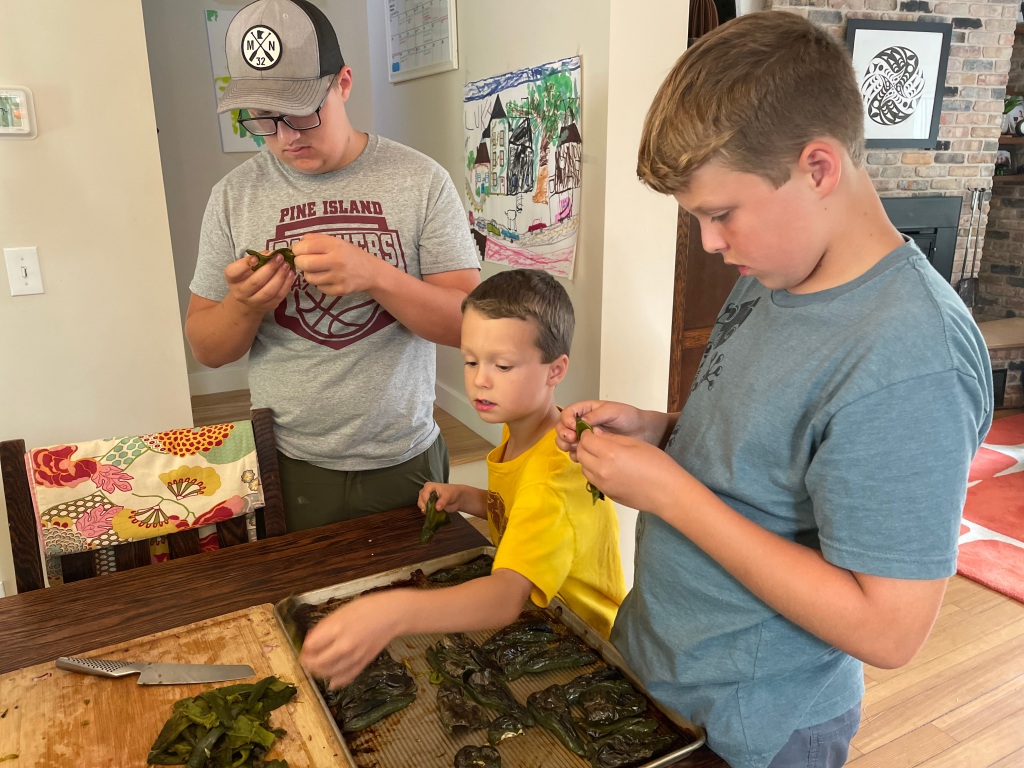
Our salsa ingredients were slicer tomatoes, poblanos, red onions, garlic, jalapenos, and cilantro, all from the farm. We did add some frozen corn because I can’t grow sweet corn for the life of me, but it was still very satisfying to see so many jars filled nearly entirely with food we had grown with our own hands.
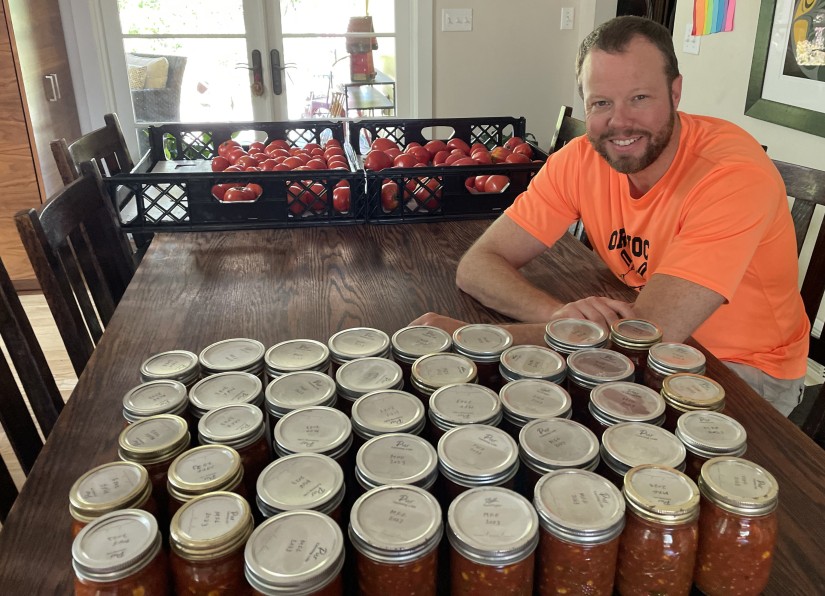
Besides putting up jars for the winter, this is also the time of year when we like to sit around the table at mealtime and name the foods on it that we grew. Often these days, it’s nearly everything and we feel both awed and grateful when that happens. Especially in this year of extreme drought, we are amazed at the resiliency of the plants in our field. Yes, we’ve been helping them along with watering and shade cloth, but even so – despite some setbacks, delays, and reduced yields – the gifts we’ve received are plentiful.
Of course, I did have to keep up with the watering (so what else is new?!), but I ordered the drip irrigation system for next year which will dramatically change the workflow on the farm and allow me to do some other things that I’ve been wanting to get to. This will improve the sustainability of the farm as it will use a lot less water than hoses and sprinklers and it will help with the sustainability of your farmers, too!
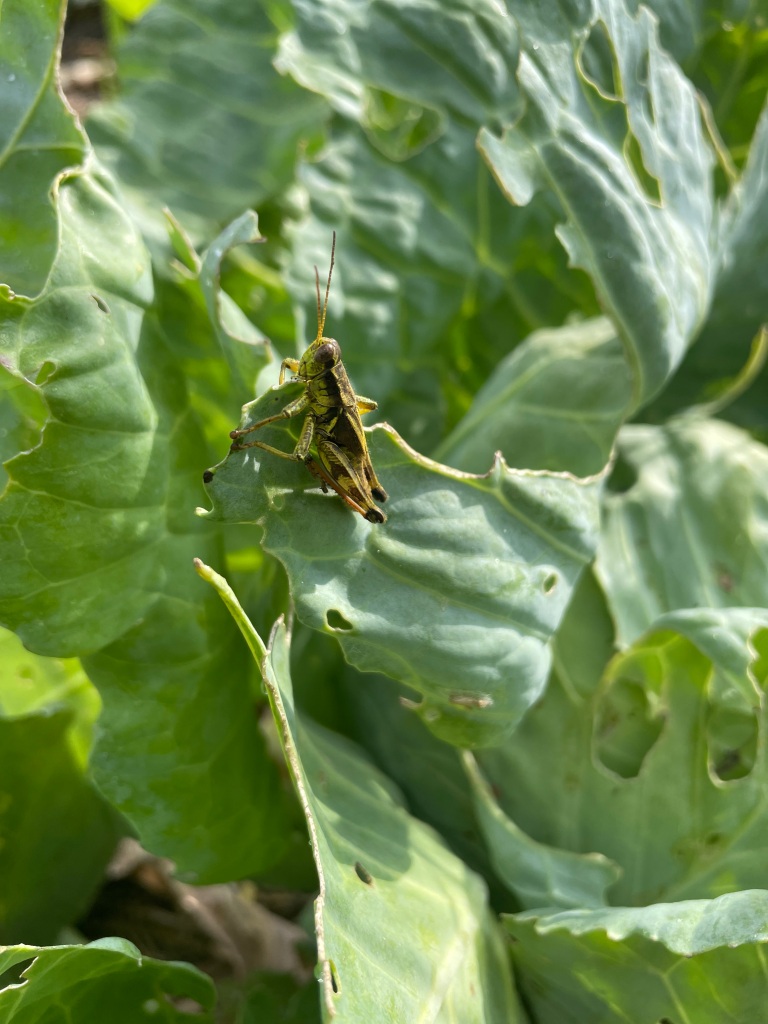
One thing that I’ve been noticing in the field this summer is the near-plague of grasshoppers down there. Every year there seems to be one bug that defines the season. Five years ago, it was slugs who were all over the brassicas; we would pull up the straw mulch underneath the plants and find dozens of them huddled together. (Sorry. I know that’s gross!). Then there was the potato beetle year and the cucumber beetles year. 2023 is definitely the year of the grasshopper. There-are-so-many-grasshoppers!
In fact, as I was walking by the winter squash field last week, I thought that I heard the bunny crashing around in there, but it turned out that I had just disturbed about a gazillion grasshoppers instead.
I learned why the grasshoppers are this prolific right now. It turns out that usually, when soil moisture is where it ought to be, there is a fungus which preys upon grasshopper eggs. Dry soil = no grasshopper-egg-eating fungus = a lot of grasshoppers.
Also, since their primary food source (you guessed it!) – grass – is essentially dead everywhere, they have no choice but to move into vegetable field if they want to have something to eat. Many of the nibbles you see on our leafy greens and brassicas are probably from grasshoppers this year.
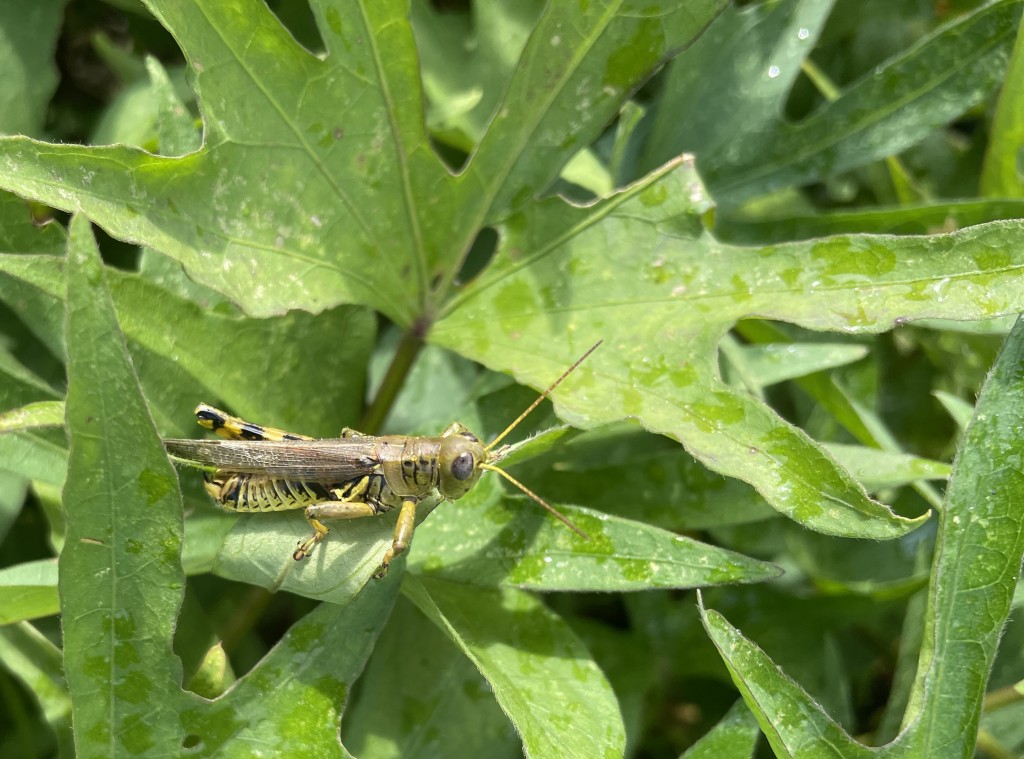
Recipes
Crispy Italian Fried Potatoes and Peppers // Uses Italian Frying Peppers (recipe calls for Green but you can use also use Red and Yellow), Potatoes // Vegetarian
Cubanelle and Black Bean Pork Chili // Uses Garlic, Tomatoes, Substitute Italian Frying Peppers for Cubanelle
Fresh Garlic Pickles without Dill // Uses Garlic, Pickling Cucumbers // Vegetarian
How to Pickle Cucumbers in 10 Minutes // Uses Garlic, Pickling Cucumbers // Vegetarian
Italian Frying Peppers – 3 Delicious Ways to Cook // Uses Italian Frying Peppers // Vegetarian
Potimarron Farci – Uses Parsley, Potimarron Squash // Vegetarian
Roasted Potatoes and Brussels Sprouts // Uses Brussels Sprouts, Potatoes // Vegetarian
